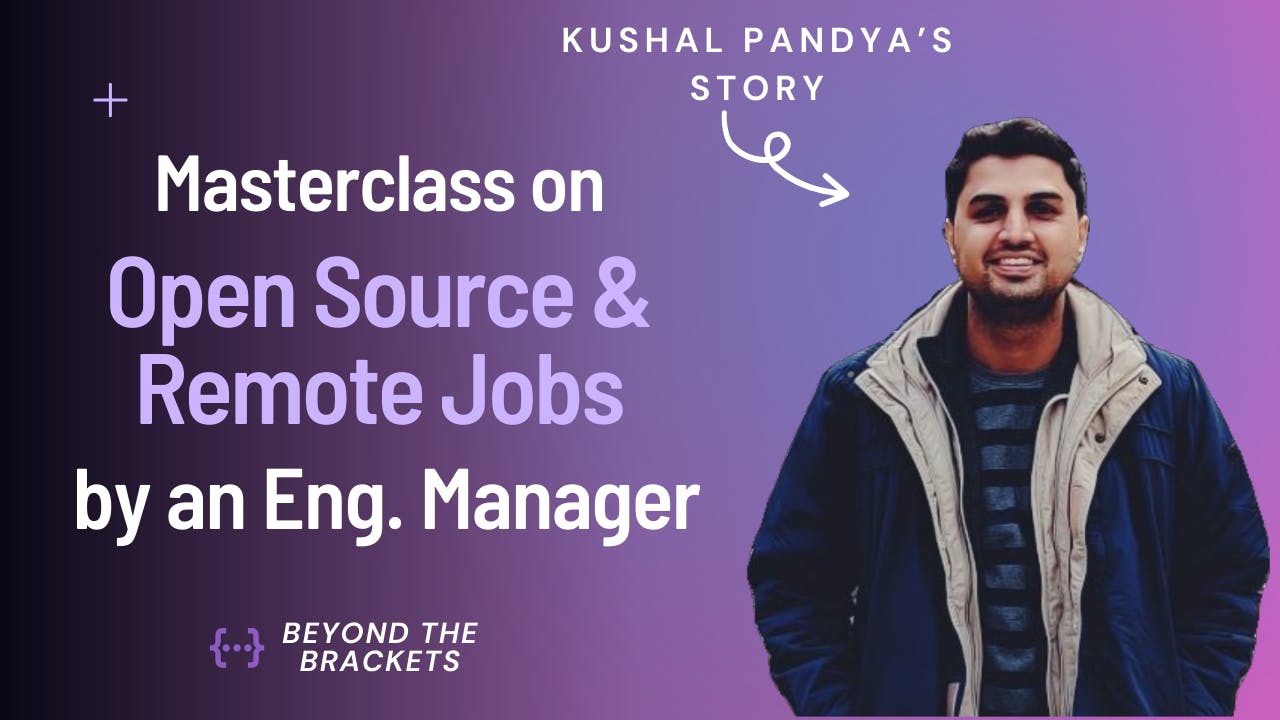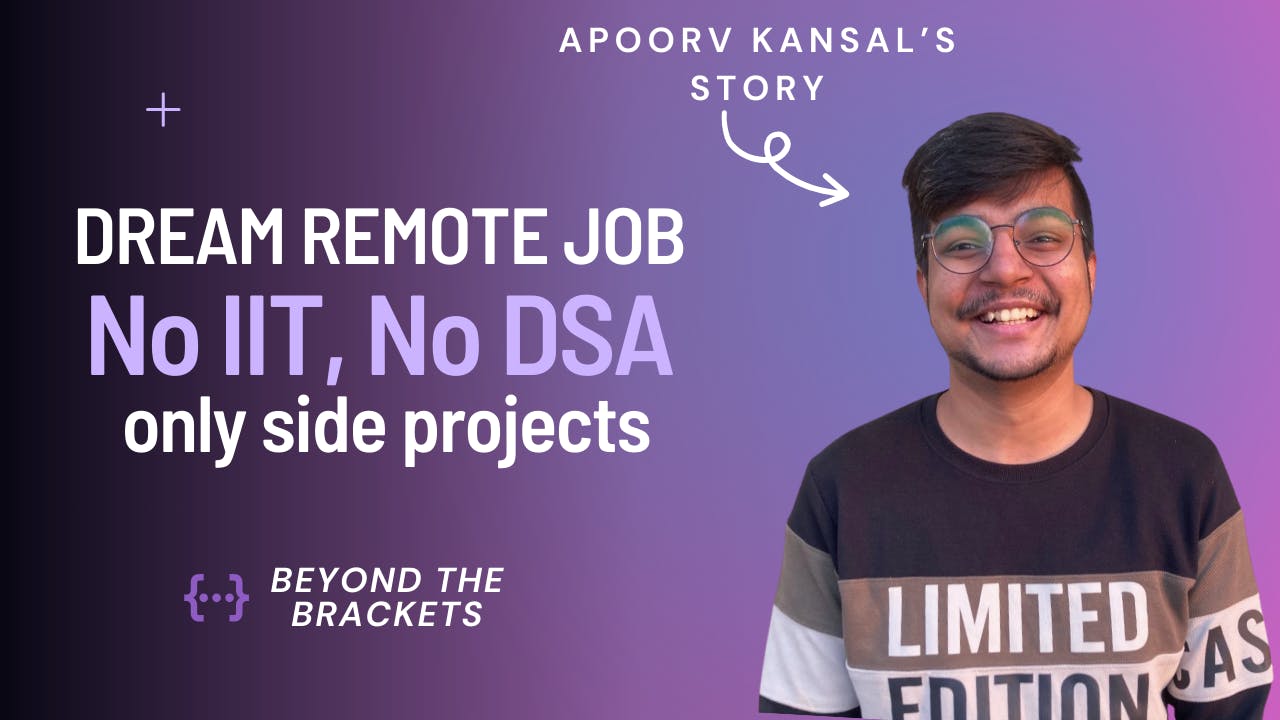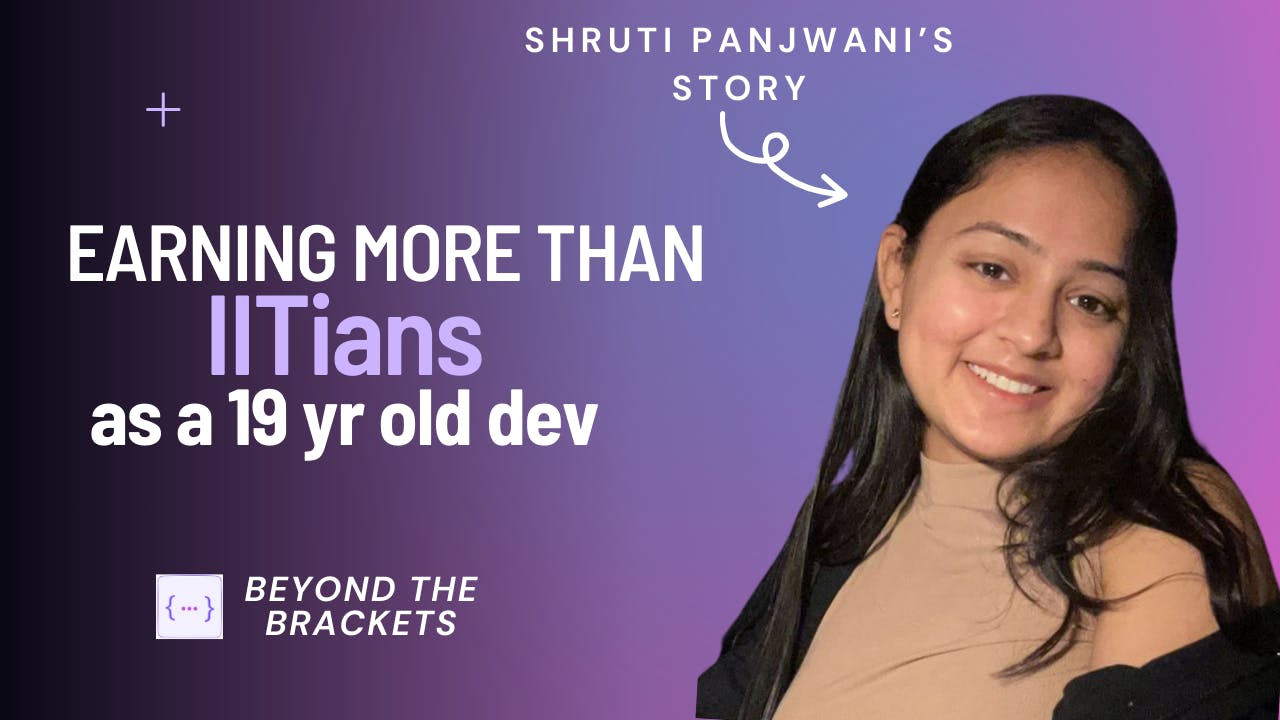8 ways Indian developers find amazing remote jobs (without going to IIT or getting a Master's)
I interviewed 8 developers working amazing remote jobs. Everyone had a different origin story.
Over the past month, I have been interviewing developers on Beyond the Brackets. Indian developers. Amazing developers. Woking envious remote jobs for companies outside of India.
I found a lot of surprising commonalities in their stories. Like:
None of the people I interviewed are from IITs or any tier-1 engineering college (even though this wasn't a filter in the interview selection process)
Most of them had a humble start to their career - sometimes earning less than ₹10k/month in their first jobs
All of them know real development work - not just how to solve leetcode-type data structures and algorithms problems
Each of them has a unique way of stumbling upon their first remote job
Last point is the most important one. If you're reading this, chances are you aren't working a remote job yet. But you probably want to. How do you suppose you can get one? Applying to those remote-only job boards?
Well, here's another interesting fact - none of the developers who we interviewed have got their job through them.
This is not to say that they are useless but rather that there are many more ways of finding your dream job than you might know.
Here are 8 of them:
Cold emailing the CEO of the startup
Making an open source project
Teaching an online course after getting laid off
Contributing to the company's open source repository
Networking at local meetups
Posting a side project on Twitter and tagging the framework used
Writing about new things you learn on LinkedIn
Getting in a talent network
If you're curious to learn exactly how these lead to a remote job, continue reading because I'll write about their stories and tell you exactly how these tactics worked for the interview guests.
If you want to be notified of future interviews, subscribe to the email list here (it's free). We also invite subscribers to exclusive live Q&As with the guests.
(Also note that none of the above mentioned methods are unique for the Indian market. You can easily apply the same lessons regardless of where you live.)
Cold emailing the CEO of the startup
This is the story of how Saurabh Sikchi got his dream remote job working for a CEO that he admired.
Saurabh is a Ruby on Rails developer at Open Regulatory, a fully remote bootstrapped startup. He joined them as the 5th employee. Here's how it happened:
One day, while browsing Hacker News, he came across a post from the founder of OpenRegulatory that impressed him. Saurabh loved the founder's writing style and the clarity of thought it conveyed. So, he decided to write him an email. What did he say?
He just appreciated the founder on his writing. He told him that he was not looking for a job but he was willing to make an exception for their company. Note how this is not your typical "spray and pray" approach where you write the same email to multiple companies.
And it worked!
The founder was impressed with this email and replied saying that.. they didn't have the budget for another hire. But he kept Saurabh in mind. A few months later, when an opening came up, he reached back out to Saurabh. And after a few rounds of interview, Saurabh was in!
Lesson? Talk to people. If you find some founder doing something interesting at their company, reach out to them. Genuinely appreciate them and tell them why you like their approach. Then, ask them for a job.
Making an open source project
This is the story of how Burhanuddin Rashid got his first remote job.
Burhan comes from a village near Udaipur. He started his career by being unable to get a job for 1 year after college. From there he starts with a job that paid him ₹6.5k/month, slowly growing it by switching companies. Until he got a life-changing opportunity to work at a remote US-based startup.
Here's how it happened:
Burhan is a mobile developer who works with Flutter. While learning Flutter he built a todo app to solidify his learning. What he did differently from most developers is that he open-sourced the project on Github and wrote a good Readme file for it. You can check it out here.
That's all he did!
Then, a CEO from a US-based startup found this project on Github when he was looking for resources on Flutter (it was a pretty new framework back then) and reached out to him over email. Burhan didn't even think this could happen. In fact, he first disregarded that email thinking that it was a scam.
But thankfully he replied to the CEO when he reached out again. That job gave him a ~300% hike in compensation!
Lesson? Do projects and publish them to Github with good readme files. Even doing simple projects helps but you can get innovative project ideas from this website.
Teaching an online course (after getting laid off)
This is how Burhan got his second remote opportunity.
He worked at the above mentioned startup for more than a year when the startup hit hard financial times. That resulted in layoffs which impacted Burhan too.
Instead of just searching for jobs, Burhan decided that he will also run a cohort-based course for junior Flutter developers who want to learn advanced Flutter concepts. He created a website for this and posted it to Hacker News.
That post was seen by a CTO from a UK-based startup who reached out to Burhan asking if he can teach Flutter to his developers. After their initial conversation, the CTO proposed an even better idea - what if Burhan joined their team full-time.
Burhan accepted the offer and got his second amazing remote job.
Lesson? Teach what you know to the people who are behind you and share it on the Internet (especially Hacker News).
Contributing to the company's open source repository
This is how Kushal Pandya got his first remote job. Kushal is an Engineering Manager at Gitlab. He has worked there for 7+ years and currently manages a team of 8 ICs spread throughout the globe.
You know Gitlab, right? It's a big US-based startup with an award-winning remote work culture. Unlike most remote companies where remote roles usually end up translating to "Remote (US-only)", Gitlab is fully remote with 2000+ employees around the world.
Kushal joined them in the early days when they were less than 100 employees. Here's how:
Kushal's previous employer was working with a non-Git based version control system. These were the days when Gitlab was still new and taking off. So he got his company involved in using Gitlab.
As an early adopter of the platform, when he found bugs to fix, he would go and fix it in Gitlab's codebase (Gitlab is open-source too). So one day, he sees a job opening in their newsletter, applies and gets in.
One key reason why he was selected? His open-source contributions.
Today he is a hiring manager at Gitlab himself. He says that the only way to stand out amongst the 1000s applicants is by having a contribution history.
Lesson? Make meaningful contributions to open-source software. Good place to start is by looking at the tools or libraries you might already be using.
Networking at local meetups
This is what led Rohit Joshi to his first remote job.
Rohit is a Ruby on Rails developer at a US-based fast growing startup called Circle. Circle is one of those rare companies that offer U.S. benchmarked compensation no matter where you are in the world. Yes, even in India!
Here's how he got this job:
He likes coding in Ruby on Rails but the company he joined after college didn't use Rails. So he wanted to work for a company that did. But he didn't know any Rails developer in his network.
So, he went on Meetup.com and started going to local Rails meetups in Pune. There he connected with many developers who were working with Rails.
It was one of those people who got him his first job as a Rails developer and ultimately at Circle.
Lesson? Network with people. Local meetups are a good place to start.
Posting a side project on Twitter and tagging the framework used
This is how Apoorv Kansal got his first remote job.
Apoorv is a Frontend Developer at Musixmatch, an Italy-based startup that powers the lyrics in places like Instagram Reels and Spotify.
Here's how he got this job:
Apoorv is a React Native developer who likes animation. So he would build little clone apps with nice animations in them. One day he decided to clone the lyrics feature of Spotify and make a little weekend project out of it using the Reanimated library.
Then, after building it he did something that a lot of people don't do - he posted it on his Twitter account and tagged the library in it. Reanimated library ended up retweeting it. That retweet was thus seen by a follower of Reanimated - the CTO of Musixmatch which uses the same library!
So, the CTO reached out to Apoorv and after a few rounds of interviews, he had got his first remote role at an awesome startup.
Lesson? Make side projects, share them on Twitter and tag the frameworks used.
Writing about new things you learn on LinkedIn
This is how Shruti Panjwani got her first remote role.
Shruti is a 19 year old fullstack developer who has 3 years of professional experience. That’s right.
She taught herself the MERN stack when she was sitting at home and started working as a consultant in her 12th standard. Then, she got her full-time job at a remote US-based startup without a college degree. Here's how she did it:
When she started learning to code, she would post the things she learnt each day on her LinkedIn account. Since she was barely 17 and in high school, she didn't have many LinkedIn connections. And the stuff she posted was also pretty basic. So her initial posts didn't get many reactions.
But as she levelled up her skills, this started to change. Soon people began to take notice. By the time she reached 2-3k followers, she started getting requests for freelancing projects. One such project was from a US-based startup which later turned into a full-time job.
Lesson? As you learn new things, share what you learn on Twitter or LinkedIn.
Getting in a talent network
This is how Shubhashish Verma got his first remote job.
Shubhashish started his career with a job at TCS that paid 3.36 LPA. Today, he works a fully remote job that pays 45 LPA.
How did he do it?
First, he was intentional about picking a stack that was gaining popularity. He didn't get that opportunity at TCS so he focused on upskilling himself away from the job. Gradually he kept levelling up as his skills progressed. From 3.36 LPA → 3.6 LPA → 17.5 LPA to finally 45 LPA right now.
The latest job offer came to him when he joined a talent network called Hyno. These talent networks only accept candidates after rigorously testing their technical skills. Once you get in, they partner with remote companies to give their network access to job opportunities over there.
Lesson? Try getting into a talent network that helps you get remote jobs, like - Hyno, Toptal, Turing or Pesto.
Every week, we interview developers who are working amazing remote jobs so we can share such insights with you. We already have 5 new interviews in the pipeline where we've learnt 5 more ways of getting a dream remote job. We'll be publishing those stories in the coming weeks.
If you would like to be notified when we publish them and get an opportunity to ask these developers your questions, enter your email here.
You can also follow us on LinkedIn and subscribe to our Youtube channel.






